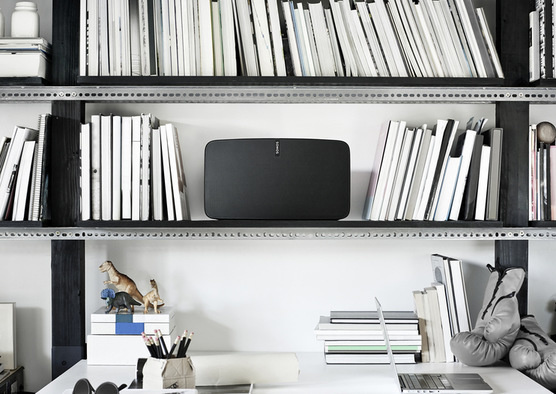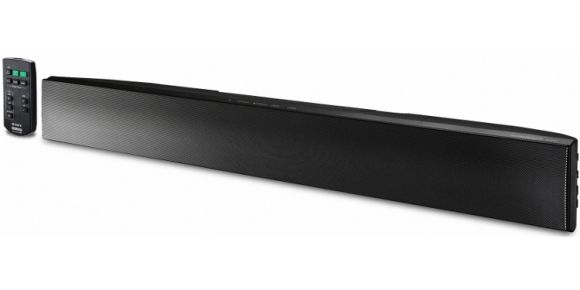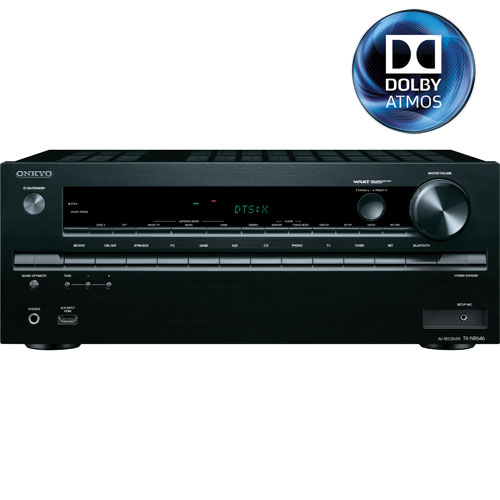
If you’re new to home theatre, or just beginning to look at taking your TV setup up a notch, there are several things to consider. What kind of system should you get? Do you need lots of components or just a few? Can you go fully wireless? Or maybe you just want a perfect way to tune out the world and watch your favourite shows on TV in peace, and without screaming kids interrupting (hello headphones!).
There are several options for your home theatre, depending on your budget and your personal style, as well as how much of an audiophile you are (or want to be). Let’s take a look at three main configuration options for home theatre, and some product picks for each.
Wireless and Versatile
 This is by far the easiest and can sometimes be the least expensive option. Wireless speakers are gaining popularity, in part because they’re easy and versatile. They tend to be smaller and more compact, and they’re easy to relocate. With options like the Sonos line, or Bose SoundTouch, you have the ability to add as many speakers as you like, wherever you want them (or as your needs grow or change), and they’ll work together in concert to give you a rich and full audio picture. I wrote all about the Sonos line recently, and about some of the Bose options. Wireless speakers can be placed anywhere, and are controlled by one app that you run from any smart device.
This is by far the easiest and can sometimes be the least expensive option. Wireless speakers are gaining popularity, in part because they’re easy and versatile. They tend to be smaller and more compact, and they’re easy to relocate. With options like the Sonos line, or Bose SoundTouch, you have the ability to add as many speakers as you like, wherever you want them (or as your needs grow or change), and they’ll work together in concert to give you a rich and full audio picture. I wrote all about the Sonos line recently, and about some of the Bose options. Wireless speakers can be placed anywhere, and are controlled by one app that you run from any smart device.
Components to consider
Sonos speakers run off your home’s wifi network. You can also add what Sonos calls its Bridge or Boost, which provides a hardwired connection and makes scaling up your system more reliable by providing its own dedicated network for the system to run on. To read more about the Sonos line and how it works, check out my article here.
Another similar system is the Bose SoundTouch line. I recently had a chance to test the entire line, and I can tell you the sound is phenomenal (See my video review at the bottom of this article). There are three different size speakers in the line, giving you versatility for both the size and scale of the room where you’ll want them. Similar to Sonos, they also can be grouped together to give you a house-wide audio stream.
How much room do you need?
You need almost no space to house just about any of these speakers. They’ll tuck in a corner, under your TV, in a stereo cabinet or just about anywhere. Wireless speakers make a great choice for small rooms, dorms, trailers, and of course for people who can’t be bothered with complex setups or wires.
Installation Consideration
Installing wireless speakers is easy. For the most part, you unpack them from the box, download an app, plug in the power, and you’re ready to go in minutes, literally. That was my experience with the Bose SoundTouch line, so it’s a good option for people who don’t want a complicated technological experience.
Simple and Connected
If you’re looking for a dedicated audio option to work with your TV, but you’re not quite ready for a full-pull home theatre system, a soundbar is the way to go. 
Soundbars connect to your flatscreen, and provide much better sound than the built-in speakers in the set. Not just better sound, but actual quality audio that you just can’t get through the TV. Why? As I wrote in a recent article, part of the reason is fancy flatscreens themselves. As manufacturers have thinned our TV screens, there’s much less room left for a quality speaker in that narrow package. This results in wispy, tinny sound that can’t carry those low tones. Add in the fact that in many cases the built-in TV speakers are pointing to the rear, or to the sides, and you’re not optimizing the sound’s directionality, meaning you’re going to get muffled audio. A soundbar will give you a true audio experience. Want to know what qualities to look for in a soundbar? Check out Tom Brauser’s recent write up on the blog.
Components to consider
Prices for soundbars range from inexpensive to luxury, so the only limit in choice is your budget. A great mid-price choice, and the one I bought for myself, is this one from Sony. It has everything in one sleek package, making it streamlined.
If you’re looking for top of the line audio quality, you can go up the ladder to something more like this Samsung Sound Bar with Wireless Subwoofer, but you’ll also need a place to stash that sexy subwoofer.
How much room do you need?
While soundbars are not large, they do require dedicated space, usually above or below your TV, so you do need to take location into account.
Installation Consideration
Installing a soundbar can be easy, or slightly more complicated, depending on your preference, and your skill with tools. For many, it’s as simple as unwrap, plug in, and they’re ready. While you can easily sit the soundbar on some furniture under your TV for the no-fuss option, you can also wall mount one for a more streamlined look. In my living room, our flat screen is mounted under the soundbar, and the whole kit can be covered by a slide-into-place painting to keep the room tidy when we’re not watching TV. (Yes, that’s advanced level installation best left for serious do-it-yourselfers).
The All Out Theatre Experience
This is the top of the line experience. When you’re going top of the line, you can have as many home theatre toys as you want, or as many as your budget will allow. 
If you’re going all out, you’ll want the best sound experience possible. Dolby Atmos is a top choice. It delivers multidimensional or “3D” sound that fills the room for truly immersive entertainment. Music, sound effect and voices will come alive in breathtaking detail, making you feel like you’re truly there.
What makes Dolby Atmos different?
Overhead sound is an integral part of Dolby Atmos. Adding this capability to your home theater system is key to your multidimensional experience. Dolby Atmos enabled speakers are specially engineered to direct sound upward, where it reflects off the ceiling to produce an incredibly lifelike re-creation of overhead sound. Read in-depth about Dolby Atmos here.
Components to consider
You’ll need an AVR (audio-video reciever), preamp/processor, or home theater in a box (HTIB) that supports Dolby Atmos, and many manufacturers do. All decoding, rendering, and processing is managed by the Dolby Atmos enabled AVR. Dolby Atmos content plays through standard Blu-ray™ players and streaming media players connected to the AVR via HDMI® and with the bitstream output function engaged. The good news: if you already have a 5.1, 7.1, or greater surround sound system, you’ll most likely be able to build on it. And it may not even take up any more space than your current system. You can also find Dolby Atmos packages (also called “home theatre in a box” as noted above) with reciever, speakers, etc. all in one.
Aside from the above-noted overhead speakers, you’ll need standard surround sound speakers. Whether they’re placed on the floor, on stands, or mounted on the wall, most speakers that produce audio at the head or “listener” level will work nicely in a Dolby Atmos setup.
How much room do you need?
In this configuration, you’ll definitely need space. It helps if you have a dedicated home theatre with room for several speakers, a wall unit for the components, and a gorgeous TV. When it comes to choosing a Dolby Atmos speaker setup for your home, there’s no one right choice, mainly because Dolby Atmos configurations can support up to 34 speakers in total. Your only limit is your own space and your budget.
Installation Consideration
If it were me, I’d want help with this one. Best Buy has Geek Squad service to make things easy, and the best part is the initial consultation is free. Geek Squad Home Theatre Service will come to your house, review your home theatre needs, inspect your home environment to determine feasibility where you want your home theatre set up, then they’ll propose a setup, including product options. You can’t go wrong this way. If you’re a sharp cookie when it comes to home audio, I congratulate you, and want you to post photos of your awesome home theatre space, and tell us how long it took you.
As you can see there are home theatre audio options from dorm room to media room and from simple to complex. Limited only by your pocketbook and your space, you can easily create the ideal home theatre or media centre that fits your home.
Here is the video review of the Bose speakers that I promised earlier:



